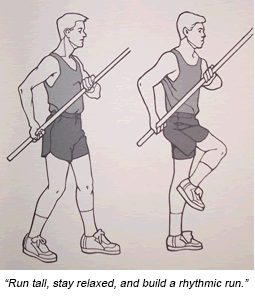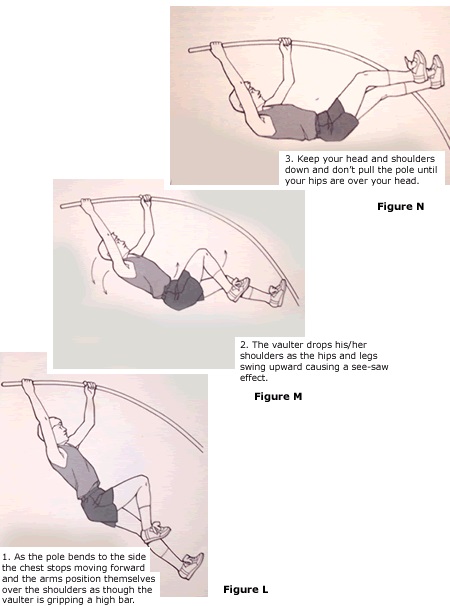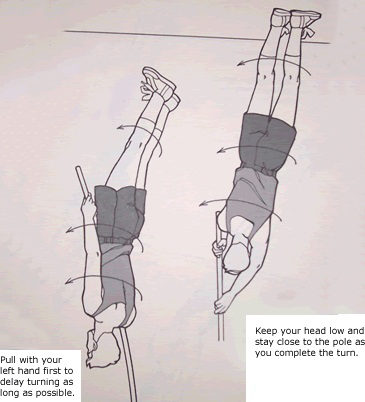Self-Analysis of Your Pole Vault Technique
Even though all vaulting poles are now made of fiberglass, many athletes still use techniques better suited for metal poles. Study your entire vault. Do you use metal (old style) or fiberglass (new style)? Or, does your vault technique vary?
The following breakdown covers most, but not all details of each phase - enough to form your comparisons of the two types of techniques.
The illustrations below represent fiberglass "new style" techniques.
POLE CARRY AND APPROACH RUN
Most athletes utilize similar techniques here - pole carried tip up high and gradually lowered as the vaulter approaches the vault box - running with knees high and feet landing underneath the knees during each stride. It's difficult to differentiate techniques in this phase.

THE PLANT
Both techniques require the top arm to be pushed upward during the Plant. However, metal style calls for driving the lower arm directly forward to the back of the vault box while fiberglass technique wants the lower arm to drive upward at a 45 degree angle from the body during the Plant. The metal style causes the pole to bend before the vaulter takes-off while fiberglass technique delays the bend to coincide with the Take-Off. Both arms push the top of the pole upward so the pole tip drops down into the vault box two-thirds of way back. It then slides to the back of the box. This modern technique delays pole bend so the athlete can drive both arms upward longer causing the pole bend to be higher than that of the older style. Also, fiberglass technique uses a Take-Off mark farther away from the vault box to set up a longer Swing phase than metal style which commonly uses a take-off mark closer to the vault box.

THE TAKE-OFF
This effectiveness of this short phase is determined by how good the Approach Run and Plant are. It's the driving action that sets up the Swing phase. The top arm stays extended upward in both techniques, but the vaulter is forced to pull the pole in the metal style due to the early bend. This makes the vaulter's top arm drag behind the body early causing the chest from moving forward and upward during the Swing. Fiberglass technique calls for pushing both arms forward
and upward so the chest is free to drive into the Swing.

THE SWING
Since metal style causes the top arm to drag behind the body at Take-Off, the vaulter's Swing is cut short and the athlete is forced to pull his top arm early - usually across the body - forcing the pole to the side. This makes the athlete move in front of the top arm and causes the pole to unbend too soon. The vaulter, instead of the pole, has to do the work. It's an example of vaulters using an old style that's not effective on fiberglass poles. The new style allows the vaulter to remain upright longer while driving the chest in front of the top arm and letting the pole do the work as the hips move forward and upward. The athlete pushes the lower arm out to position himself in front of the top arm as long as possible and behind the lower arm. The pole stays bent while the hips and legs go up the pole and the head and shoulders drop. Don't pull with the top arm - it just stays straight during the entire Swing. The Swing is complete when the hips and legs rise above the still extended top arm. Now the athlete is in an upside/down position much like a sling shot.

THE PULL/TURN
The pole loses its bend too early using Metal style. The vaulter does all the work on the unbent pole much like he would if he was using a metal pole. The tremendous power of unbending fiberglass is lost. If you use metal technique, the only advantage gained using a fiberglass pole is the bend at Take-Off allows you to hold the pole higher. After a short Swing, old style causes an early pole unbending and a pulling action across the body. The upper body turns while the lower body 'flags out' at the crossbar. Using fiberglass technique the vaulter delays the turn. Instead, he stays straight and lets the pole do the work. There is no pulling with the top arm. The lower arm pulls back towards the vaulter's body as the pole begins unbending. As the vaulter shoots upward, he turns the entire body as one unit tightly around the pole. The right arm turns with the rest of the body, but it does not pull. Once the elbow of the lower arm passes close to the unbending pole the unit turn begins.

About Bill Falk:

Bill Falk founded M-F Athletic in 1960, coached Olympic and All-American pole vaulters and had set the trend for new pole vault techniques in the U.S.A. He was the author of five pole vault books and had produced a number of track and field videos.